When it comes to bathroom plumbing materials, you’ve got several options. PVC pipes are lightweight and cost-effective for drainage, while copper pipes offer durability and corrosion resistance. PEX tubing is flexible and freeze-resistant, perfect for DIY projects. ABS pipes are easy to cut and join, making them great for drainage systems too. Don’t forget toilet flanges, essential for securing your toilet. Curious about more components like sink drains and faucet elements? There’s plenty more to discover!
PVC Pipes
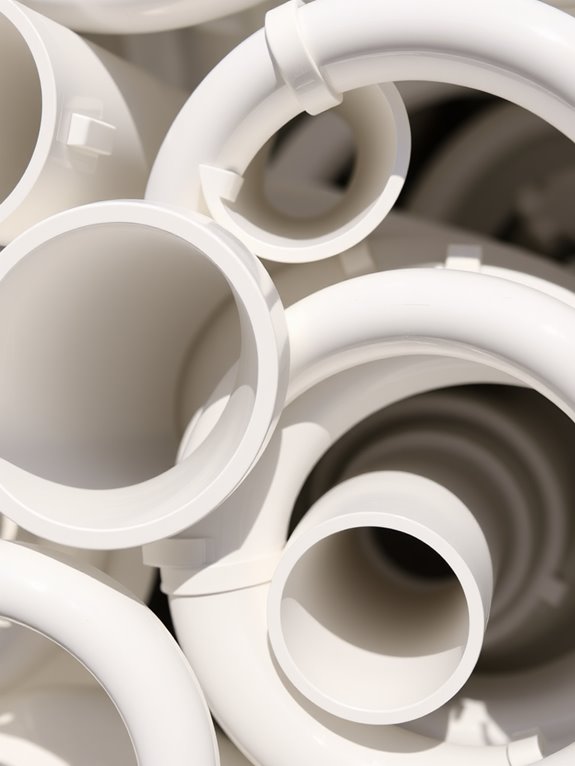
When you think about bathroom plumbing, PVC pipes often come to mind because of their versatility and durability.
These lightweight pipes are easy to handle, making installation a breeze. They resist corrosion and are less likely to leak, which helps prevent costly water damage.
PVC pipes are perfect for drainage and venting applications, ensuring smooth flow and efficient waste removal. Plus, they’re cost-effective, so you won’t break the bank when renovating your bathroom.
With a wide range of sizes available, you can find the right fit for your specific plumbing needs.
Choose PVC for reliable and long-lasting bathroom plumbing solutions.
Copper Pipes
While PVC pipes are a popular choice for many plumbing applications, copper pipes have long been a trusted option for bathroom plumbing as well. They’re durable, resist corrosion, and can handle high temperatures, making them ideal for hot water lines. Plus, copper pipes have natural antimicrobial properties, which help keep your water clean.
Here’s a quick comparison of copper pipe types:
| Type | Uses | Pros |
|---|---|---|
| Type K | Underground systems | Thickest wall, durable |
| Type L | Residential plumbing | Good balance of strength |
| Type M | Light-duty applications | Lightweight, easy to work |
PEX Tubing
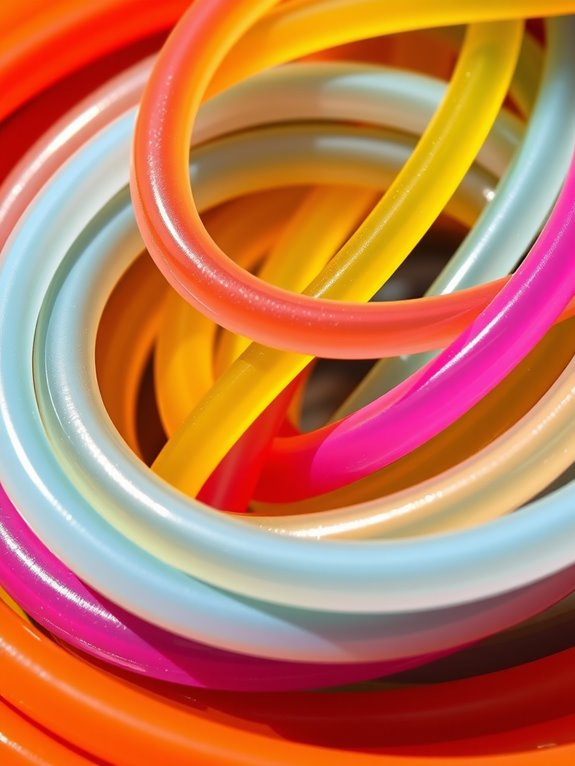
PEX tubing has emerged as a modern favorite in bathroom plumbing. Its flexibility and durability make it an excellent choice for DIY projects and professional installations alike.
Here are some key benefits of using PEX:
- Corrosion-resistant: Unlike metal pipes, PEX won’t rust or corrode over time.
- Freeze-resistant: PEX can expand slightly if frozen, reducing the risk of bursting.
- Easy installation: You can easily cut and connect PEX without specialized tools.
- Cost-effective: It’s typically cheaper than copper or PVC, saving you money on materials.
Switching to PEX can simplify your plumbing project considerably!
If you found this helpful, you’ll love this post too! What is a Plumbing Nipple: Essential Guide for Homeowners
ABS Pipes
If you’re considering alternatives for your bathroom plumbing, ABS pipes offer a robust option worth exploring.
These black plastic pipes are lightweight, durable, and resistant to corrosion, making them ideal for drainage systems. They’re easy to cut and join with solvent cement, allowing for quick installation.
ABS pipes also perform well in cold temperatures, maintaining strength without becoming brittle. Plus, they’re less noisy than other materials like PVC when water flows through them.
Here’s another post you might find useful: What is Sanitary Fittings in Plumbing?
Toilet Flanges
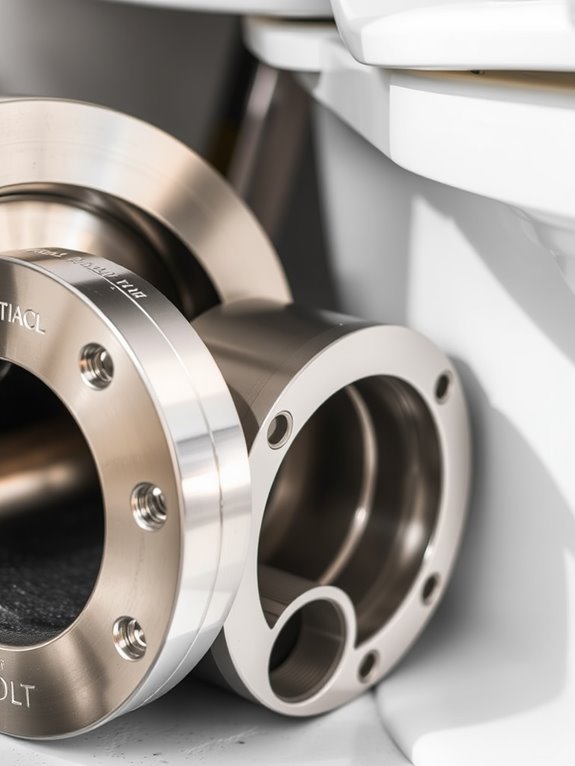
When installing a toilet, understanding the different types of flanges is essential for a secure fit.
You’ll want to follow specific steps during the installation process to avoid common issues down the line.
Let’s explore what you need to know about toilet flanges to guarantee everything goes smoothly.
Curious to learn more? Explore this resource: What is Sanitary Plumbing: Your Ultimate Solutions
Flange Types Overview
While choosing the right toilet flange is essential for a proper installation, understanding the different types available can make the decision easier.
Here are four common flange types you should know:
- PVC Flange – Lightweight and resistant to corrosion, ideal for new installations.
- Cast Iron Flange – Durable and sturdy, perfect for older homes with cast iron pipes.
- Wax Ring Flange – Often used in conjunction with a wax seal, providing a reliable connection.
- Stainless Steel Flange – Resistant to rust and ideal for high-moisture areas, offering longevity.
Knowing these options helps you make an informed choice for your bathroom project.
Installation Process Steps
Choosing the right type of toilet flange sets the stage for a successful installation.
First, turn off the water supply and remove the old toilet. Next, clean the area thoroughly, ensuring the subfloor is even and free of debris.
Place the new flange over the drain pipe, making sure it’s level and properly aligned with your bathroom floor. Secure it to the floor using screws, ensuring a tight fit.
Finally, attach the toilet to the flange, making sure the bolts are snug. Reconnect the water supply, check for leaks, and enjoy your newly installed toilet!
Common Issues Addressed
Although toilet flanges are essential for a secure toilet installation, they can present several common issues that may disrupt your bathroom’s functionality.
You might encounter:
- Leaking: Improper sealing can lead to water seepage.
- Cracking: Flanges can crack due to weight or shifting, causing instability.
- Corrosion: Metal flanges may rust over time, weakening their structure.
- Improper Height: If the flange sits too high or low, it can result in leaks or toilet wobbling.
Addressing these issues promptly guarantees a long-lasting, efficient bathroom setup.
Regular maintenance can help you avoid these common pitfalls and keep everything running smoothly.
Don’t miss out on related tips: Read this next: Where Does a Sanitary Plumbing System Begin and End?
Sink Drains
Sink drains play an essential role in your bathroom’s plumbing system, efficiently directing wastewater away and preventing clogs.
You’ll find various materials for sink drains, including PVC, metal, and brass. Each option has its benefits; for example, PVC is lightweight and resistant to corrosion, while metal offers durability and aesthetic appeal.
When installing a sink drain, make sure you use the correct size to fit your sink and plumbing. Regular maintenance, like cleaning the trap, can help you avoid blockages.
If you notice slow drainage or unpleasant odors, it’s time to check your sink drain for potential issues.
Shower Valves
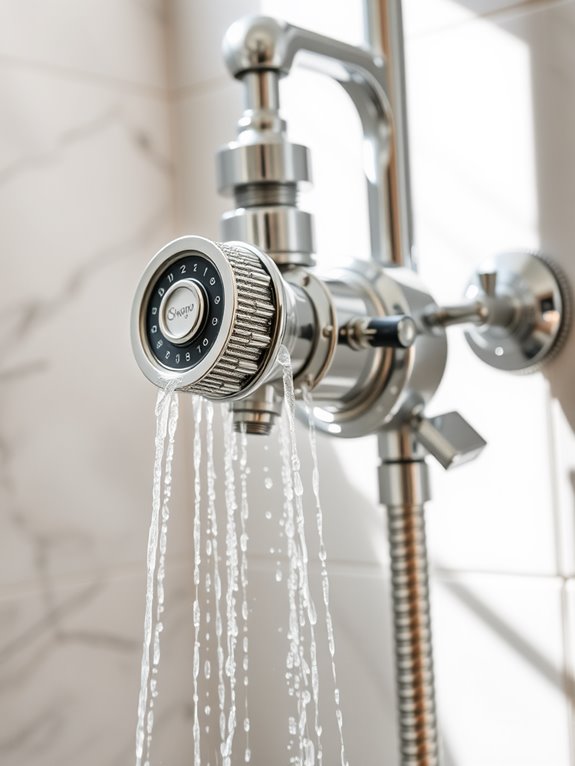
After verifying your sink drains function smoothly, it’s important to reflect on the role of shower valves in your bathroom plumbing.
Shower valves control water flow and temperature, making them essential for a comfortable shower experience. Here are four key points to take into account:
- Types: Choose between pressure-balancing, thermostatic, or manual valves based on your needs.
- Installation: Proper installation guarantees peak performance and prevents leaks.
- Maintenance: Regular checks can prevent issues like low water pressure or temperature fluctuations.
- Quality: Investing in durable materials, like brass or stainless steel, can enhance longevity and performance.
Faucet Components
Understanding faucet components is essential for maintaining a functional and efficient bathroom.
You’ll encounter several key parts, including the handle, spout, cartridge, and aerator. The handle controls the flow and temperature of water, while the spout directs it where you need it.
The cartridge is vital for mixing hot and cold water, and it can wear out over time, causing leaks.
Finally, the aerator helps reduce water usage while maintaining pressure.
Familiarizing yourself with these components not only aids in repairs but also enhances your faucet’s performance, ensuring a comfortable and eco-friendly experience in your bathroom.
Pipe Insulation
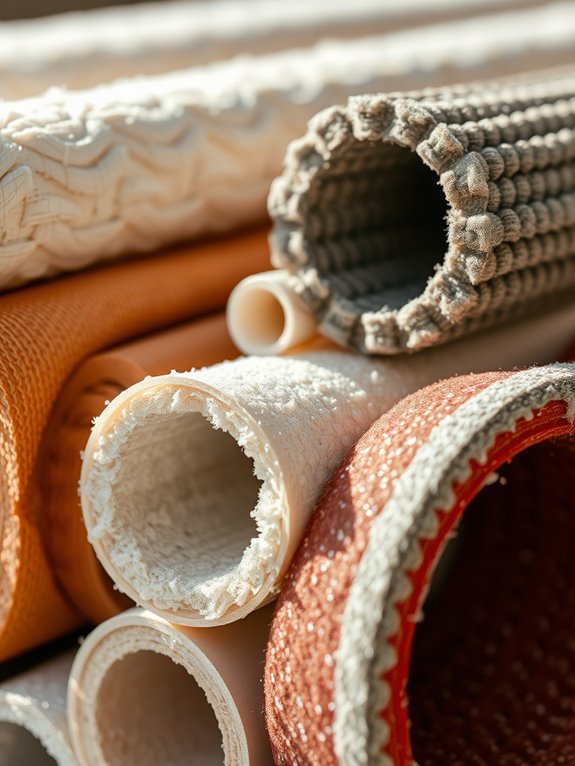
Pipe insulation plays an essential role in maintaining your bathroom’s plumbing efficiency. It helps regulate temperature, prevent condensation, and reduce noise.
Here are some key benefits you should consider:
- Energy Savings: It minimizes heat loss, lowering your energy bills.
- Preventing Freezing: Insulation helps protect pipes from freezing in colder months.
- Condensation Control: It reduces moisture buildup, preventing mold and mildew.
- Noise Reduction: Insulated pipes can considerably decrease the sounds of water flow.
Conclusion
In wrapping up your bathroom plumbing project, you’ve got a toolbox of options at your fingertips. From the sturdy embrace of PVC to the flexibility of PEX, each material plays its part in creating a harmonious flow. With a sprinkle of ingenuity and a dash of know-how, you can navigate the world of toilet flanges and faucet components with ease. So, roll up your sleeves and plunge into it—your dream bathroom awaits, just a few connections away!

I’m Allen Kim, the chief editor of plumbinginto. I am a mid level plumber and assign to an local firm over 4 years of experience. During the working period, most of my experience is related to the house plumbing. I learned about the thing, when working with most experienced people in this sector, one must be as good as the inspector or better with knowledge of the project as well as the practical aspects of plumbing industry.